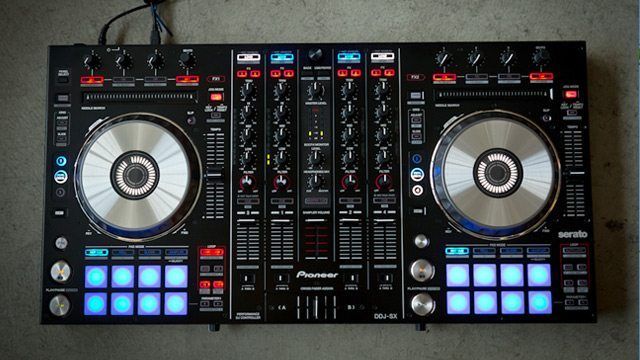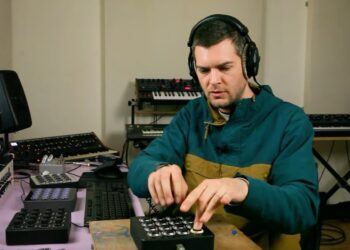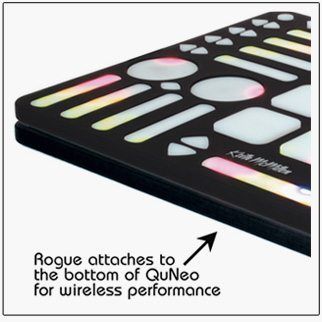Behind every good DJ software, there is a great controller. Was that not written in stone? Along with the recent release of Serato DJ, Pioneer has launched its flagship controller, the monstrously sized and devilishly fun DDJ-SX controller and audio interface. Besides just high-end, great-feeling controls, it unlocks from the software Dual Deck Control, Slip mode, Loop Roll, Slicer, and other powerful performance tools.
Editor’s Note: The DDJ SX was updated in August, 2014. Check out the new controller here.
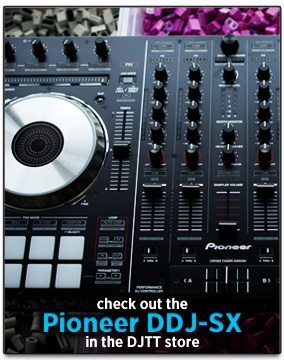 Reviewed: Pioneer DDJ-SX Controller for Serato DJ
Reviewed: Pioneer DDJ-SX Controller for Serato DJ
Manufacturer: Pioneer, with collaboration from Serato
Price: $1,199 (MSRP), $910 in the DJTT webstore
Availability: Now
Weight: 12.8 pounds (5.8 kg)
Dimensions: 26.1 x 14.1 x 2.8 inches (66.3 x 35.8 x 7.1 cm)
The Good: Awesome pad performance section. Dedicated filter per channel. High-quality, responsive jog wheels. Robust construction. Needle Search touchstrip. Slip Mode. XLR and RCA main outputs, Booth Out, level meters for each channel. Two headphone outputs; two microphone inputs. Cool light show ensues after sitting idle.
The Bad: Its sheer size can cause problems integrating it into a performance space. Have to be careful not to touch Needle Search when playing the effects section. No kill switches for the EQs.
The Bottom Line: While size and price may be detractors, the DDJ-SX uses every inch of its surface to ensure maximum effectiveness over the new Serato DJ software. With the effects sections, Slip mode, Dual Deck mode, 8 cue points and loops each per track, Loop Roll, Slicer, and a Sampler launcher, the DDJ-SX sets the stage for you to go off on a Serato controller like never before.
HARDWARE/SOFTWARE INTERTWINED
Although you can use the 4-channel mixer portion of the DDJ-SX to connect turntables, CD decks, and other external sources and pass through audio to the main outs without connecting to a computer, obviously the main attraction to the DDJ-SX is its integration with the new Serato DJ software. Virtually every button and other control on the Pioneer unit correspond directly with a Serato DJ function.
Serato has also worked with Pioneer to program Serato DJ compatibility with the DDJ-SX’s Dual Deck Control and Slip Mode. Dual Deck Control turns on with the Dual Deck button on each DDJ-SX deck, and it means that the two tracks playing on the deck (either tracks 1 & 3 or 2 & 4) will be controlled simultaneously, so you could, for example, scratch both tracks or hot cue both tracks at once.
With Slip Mode engaged from the Slip button on either DDJ-SX deck, the track playing in Serato keeps its linear play position active while you scratch, perform hot cues or loops, and then snaps back to the linear position when you are finished (see a simple demo in this clip on YouTube). This can be really fun and sound very cool when used with accurate timing. So for example, if you have cue points set up marking distinct sounds such as a crash, kick, snare, or any good vocal drop or sound effect, in Slip Mode you can drop those sounds in rhythmically at any point during playback, and then playback continues as normal when you take your finger off the pads, or the jog wheel in the case of scratching in Slip Mode.
You can have Dual Deck Control and Slip active at the same time, and when I did, even after getting really busy with cue points and loops, the software reacted in lock step with the hardware, offering no noticeable latency. (Tested the DDJ-SX on a 2012 MacBook Pro with a 2.6GHz Intel Core i7, 8 GB RAM, and OS 10.8.2 , the same machine used for the DJTT review of Serato DJ.)
BIG LOVE
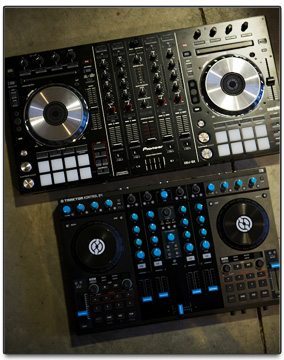
Seemingly, every big new DJ software iteration needs a big ol’ flagship controller with which to welcome it into the world. Traktor Pro S4 had the Kontrol S4, and Serato Itch had the Queen Mary of all DJ controllers, the Numark NS7. Pioneer landed on a size between those two units for the DDJ-SX, but nevertheless, it’s big—quite big. At 26.1 x 14.1 x 2.8 inches, it was actually too big to take to either of the DJ gigs I had while testing it. In fact, it’s probably too big to comfortably take to any of the last four DJ booths I’ve performed in. However, that doesn’t mean I wouldn’t try. T he surface area of the DDJ-SX doesn’t go to waste. Every inch of it squeezes out the ample potential power of Serato DJ, and makes performing with the new software a real treat.
Despite the size of the DDJ-SX, it weighs less than 13 pounds, which is still more than most all-in-one DJ controller/soundcards, but nothing compared to the 35 pounds of the beastly NS7. To save weight, the DDJ-SX doesn’t go crazy with the metal construction. It’s solidly built, but the aluminum elements are saved for the top panel and jog wheel face plates. It’s also made to be a truly all-in-one controller that you don’t need to fortify with secondary controllers (although you can, as per Serato DJ’s new capability), so that’s another plus in the consideration.
BROWSING TRACKS
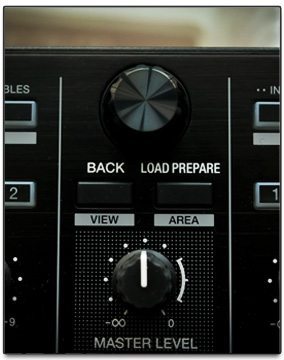
At the top of the DDJ-SX’s center mixing section, a push-button encoder and six buttons with Shift functions make of the efficient track-browsing section. The encoder scrolls through your folder tree on the left or the main track browser, and pushing the encoder or the Back button beneath it toggles between the two areas. The four Load buttons at the top of each mixer channel load a selected track to any deck (or any number of decks) quickly. Using the Shift keys, the Load buttons work to organize the tracks in the browser by Track#, BPM, Song, or Artist.
The Load Prepare button beneath the encoder loads a selected track to the Prepare area of the Serato DJ browser, which can be used as a holding area for tracks or for dragging tracks into crates. With Shift, the Load Prepare button scrolls through the Serato DJ browser: Files, Browse, Prepare, and History. Using Shift with the Back button scrolls through the different Serato DJ layout views.
With just a small sliver of the overall DDJ-SX footprint, you can quickly find and load your music and toggle the look of the Serato DJ software without ever touching the computer.
Check out our Serato DJ review to read more about how the software performs!
THE MIXER
Pioneer draws upon many years of experience making revered DJ mixers, as well as industry standard digital audio players, so it’s not too surprising that DDJ-SX hardware could hold its own even outside of the controller space.
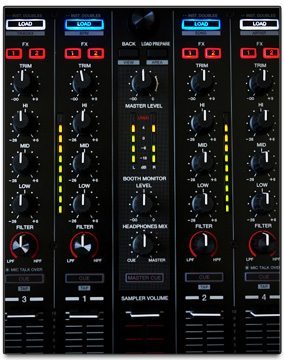
There’s no pulling of double-duty on the mixer portion of the DDJ-SX. Each of the four decks supported by Serato DJ have a full channel strip on the mixer, and these channels can also work for two additional external sources each. Even the SP-6 software sampler gets its own volume fader in the center of the mixer section.
Each mixer channel strip starts at the top with FX assign buttons that glow red when activated. Each channel is assignable to FX1, FX2, both, or neither. The Trim (gain) and three EQ-band knobs per channel have a rubber grip, and the EQ knobs and a dedicated channel Filter knob both have center detents.
The EQs don’t have kill switches, but potting them all the way to the left effectively kills that frequency band (when all three EQ knobs are turned fully left, no sound emits). The channel Filters are lowpass to the left and highpass to the right, with no filter in the center position. Every channel has its own LED level meter in addition to the master level meter in the center, which is a nice touch.
Each channel’s Cue button also doubles as a Tap tempo button for that deck with the Shift key. The 50mm channel fader throws are actually a bit short, but the faders have a nice middle-of-the-road action to them—not too stiff or too loose. You can also use Fader Start with the channel faders: with a Cue assigned to a track, turn the fader all the way down, and then press Shift and turn up the fader to begin the track.
With switches as the bottom of the channel strips, you can assign any of the channels to the A or B position of the crossfader, or designate it as “Thru,” where the channel ignores the crossfader and goes straight to the master out. The crossfader itself has a nice smooth and loose action to it as well, but it’s not super high-end and it is replaceable. A crossfader curve knob on the front panel adjusts from smooth to quick cuts, and the button pushes in to stay out of the way when not needed.
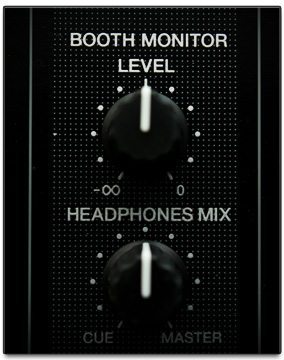 Down the center of the mixer, you have a Master Level, Booth Monitor Level, and Headphones Mix, all with rubber knobs. The Master Cue button sends everything to the headphones cue, including external sources like analog hardware or the computer’s system output.
Down the center of the mixer, you have a Master Level, Booth Monitor Level, and Headphones Mix, all with rubber knobs. The Master Cue button sends everything to the headphones cue, including external sources like analog hardware or the computer’s system output.
Those external sources have plenty of input options on the back panel of the DDJ-SX. Channels 1 and 2 have Phono/Line RCA jacks, with a grounding post between them for turntables. Channels 3 and 4 both have line-level RCA inputs for CD players, iPods, etc. and Mic inputs. Mic 1 is an XLR/1/4″ combo input, while Mic 2 is a 1/4″ only input. To select the input sources for the four channels, front panel switches for each channel select from the PC source to either of the two external sources per channel.
AUDIO INTERFACE & SOUND QUALITY
We were not able to find the official Pioneer specs for the audio resolution of the DDJ-SX’s built-in soundcard, but it does sound quite good, and there is a well-appointed output section. Dual headphone jacks on the front panel (1/4″ and 1/8″ sizes) can be used simultaneously and have a push-in Level knob.
On the back panel, 1/4″ Booth Outs accommodate either balanced or unbalanced TRS connections, and there are two Master Outs: one for unbalanced RCA and one for balanced XLR cables. I definitely appreciated the professional touch of XLR outputs, and with the right cables, the XLR connectors lock into place for safety.
Testing the DDJ-SX against other interfaces such as the Kontrol S2, M-Audio Conectiv and Stanton DJC.4, the DDJ-SX pretty much held its own as far as sound quality, not distinguishing itself much and so by default earning good marks for sound. I’m finding lately that the playing field for mid-priced soundcards (which is what these all are, considering the price differences are for the controller features) seems awfully level. The noticeable differences are slight ones when it comes to the overall fullness or “roundness” of the bass and some small differences in stereo image width.
Where the DDJ-SX really stood out were its enormous output levels. All other things being equal, the headphone Level and Master Level knobs on the DDJ-SX sat a little further to the left than on the S2 and DJC.4 to get the same big sound. Keep in mind that the DDJ-SX must be run with an AC adapter (there’s no USB bus power option), so Pioneer didn’t have to concern itself with limits to the audio output levels on bus power.
STACKED DECKS
Unlike some controllers that feature “mirror image” decks, the two decks of the DDJ-SX have the same layout from left to right. The only difference is that Deck 1 has a Panel Select button, which scrolls through the Record, FX, and SP-6 sampler panels in Serato DJ (again, see our Serato DJ review for more on those).
Going up the left side of the decks, there are buttons for Play/Pause, Cue, Sync, Shift, deck select (1, 3, Dual Deck or 2, 4, Dual Deck) and the Censor/Reverse button. A two-button Grid section handles commands for beat grid adjustment. If you press Grid Adjust and move the jog wheel, you adjust the beat grid interval, and pressing Grid Slide while moving the jog wheel slides the whole beat grid left or right. Shift + Grid Set sets a beat marker in the beat grid, and Shift + Grid Clear clears all beat markers.
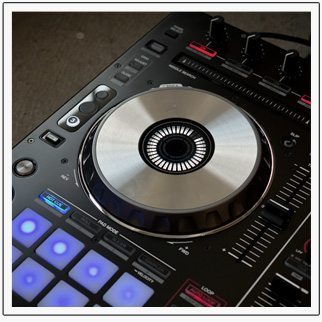 Parts of the DDJ-SX’s deck resemble a Pioneer CDJ unit, but the operation of the jog wheel definitely harkens back to the CDJs, which were the original digital scratch wheels. Pioneer was the first to convince turntablists to scratch with CDs more than a decade ago, so you know that the DDJ-SX jog wheels will be responsive and accurate for scratching.
Parts of the DDJ-SX’s deck resemble a Pioneer CDJ unit, but the operation of the jog wheel definitely harkens back to the CDJs, which were the original digital scratch wheels. Pioneer was the first to convince turntablists to scratch with CDs more than a decade ago, so you know that the DDJ-SX jog wheels will be responsive and accurate for scratching.
With the Vinyl button activated (glowing red) the top of the touch-sensitive jog wheel can be used for scratching, while the outer edge works for pitch bending. Shift + turning the jog wheel utilizes Skip Mode, where the playback position skips in sync with the beat. An LED display in the center of the jog wheel shows a spinning playback position, so that skilled turntablists can use it with a similar feel to watching a vinyl record.
You can control track pitch with a generous 100mm Tempo fader with center detent on both decks. A Key Lock/Tempo Reset button above it toggles Key Lock for the deck, and with Shift, it selects a tempo range for the deck from the limited ranges of ±8, 16 or 50%.
Above the jog wheels, each deck has a long horizontal touch strip called the Needle Search. This lets you skip very quickly to any point in the song by sliding your finger across it. The touch strip is responsive, and this feature provides an advantage; the only problem is that you have to be careful to not inadvertently touch the Needle Search while playing with the FX units, which are situated just above it.
EFFECTS SECTIONS
 Both the FX1 and FX2 units consist of four encoders and four buttons with Shift functions. These eight controls let you operate the entire FX Unit within the Serato DJ software. The buttons generally control FX on/off, Tap tempo, and two other effect-specific parameters that have stepped values. The knobs generally control the Level or Mix ratio of the effect, the timing of the beat syncing from 30 values (16th note triplet up to 32nd note dotted), and two other effects-specific parameters.
Both the FX1 and FX2 units consist of four encoders and four buttons with Shift functions. These eight controls let you operate the entire FX Unit within the Serato DJ software. The buttons generally control FX on/off, Tap tempo, and two other effect-specific parameters that have stepped values. The knobs generally control the Level or Mix ratio of the effect, the timing of the beat syncing from 30 values (16th note triplet up to 32nd note dotted), and two other effects-specific parameters.
With the Shift key, the first three FX Unit buttons all go to an effects-select menu, while Shift + the 4th FX Unit button toggles the beat syncing from the track’s analyzed tempo to a Tap tempo function.
Again, the DDJ-SX effects sections and Panel Select buttons let you open the FX Units, select their effect from a list of 10, and then operate the FX Unit completely and ergonomically without ever touching the computer. They are an important performance element to the DDJ-SX. (See our Serato DJ review for more on the specific effects offered in the software.)
LOOP SETTING
Within the compact but powerful Loop section, you can set the chosen length of loops, set and cancel auto loops, manually choose loop In and Out points, move the position of loops forward and backward in a track, choose the location out of 8 slots for a loop to be stored, and Reloop a cancelled loop.
If you have any loops already set an stored within a track, using Shift + Loop Active will activate the next upcoming loop in a track, so playback will begin to loop once the playhead gets there.
THE AMAZING PAD-O-MATIC
Saving the best for last, we arrive at the eight rubber performance pads at the bottom of each deck. These pads are of dedicated drum controller quality, and feel very firm and sturdy across their entire area, even out to the corners. You can play them with one or two fingers in rapid-fire succession.
What makes the pads so incredibly useful are the four pad modes you can choose with the buttons above them: Hot Cue, Roll, Slicer, and Sampler.
Hot Cue mode is straightforward: you set and trigger the up-to 8 cue points per track with the pads, and use Shift + a pad to delete a cue point.
The Roll button enters the Loop Roll pad mode, which is a ton of fun. First you can use the Parameter1 arrow buttons to select the loop length ranges for the pads, which will show up in the deck display of the software. I like to use the lower loop lengths, because the way Loop Roll works is that the track plays back continuously, but when you hold down a pad, it triggers a loop for as long as you hold it down, and after which the track playback continues (as if you were in the Slip Mode mentioned earlier). This is a really fun way to add some expressive riffing to your DJing without much consequence for mistakes. If you do have a timing error in your Loop Roll triggering, the playback will continue afterward unaffected, so the damage is minimal.
Things get even more insane in Slicer mode. This mode slices a section of the playing track into 8 equal parts assigned to the pads. By using Shift + the Parameter buttons, you can choose the length of the section to be divided from 2 to 32 beats. Now when you hit the pads, the slices will play in looped fashion until you release the pad and playback resumes. With the Parameter keys, you can choose if the pads loop the entire sliced section, or if they loop only 1/2, 1/4, or 1/8 of the sliced section. The shorter the slices and the shorter the portion of the slices that loop, the buzzier the loop sounds will be.
There are also 2 Slicer modes, that you toggle with the Slicer button. In the first mode, the track playback continues, and a new sliced section is created as playback passes by the old one. In the second Slicer mode, the sliced section loops back around to the beginning until you exit the mode. Unless you’re a prodigy, really masterful Slicer performances should take some time and practice. However, for highly rhythmic and minimal tracks, you could probably jump right in with some impromptu slicing. Doing that on tracks that follow traditional pop song structure could be disastrous though.
Finally, the pad Sampler mode works in conjunction with the Serato DJ SP-6 sampler. With the software sampler open and the pads in Sampler mode, you can choose between the 4 banks of samples — Banks A, B, C, and D — with the Parameter1 buttons. Each bank has four sample slots that you can fill with audio from your Library (mouse required for that).
The first six pads of the DDJ-SX decks launch the samples, while the last two pads work as back select buttons.
TO RECEIVE MAY BE BETTER THAN TO GIVE
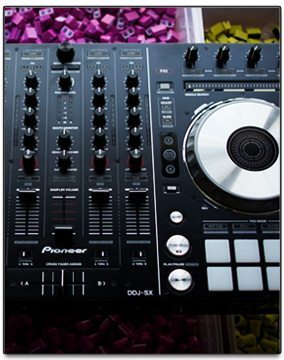 While it may be the season of giving, if you’re as enticed by the DDJ-SX as we are, good luck finding someone in your life to give you this $1,000 all-in-one controller. You may have to tighten up on your overall gift giving, and give this one to yourself.
While it may be the season of giving, if you’re as enticed by the DDJ-SX as we are, good luck finding someone in your life to give you this $1,000 all-in-one controller. You may have to tighten up on your overall gift giving, and give this one to yourself.
With that noted, however, considering the price of a single CDJ-2000 Nexus is about $2,000, the DDJ-SX doesn’t seem all that bad in the face of Pioneer’s notoriously pricey hardware. And there’s no skimping on quality here, either. The DDJ-SX isn’t all metal, but doesn’t need to be in order to be solid. Its controls — most importantly the pads, jog wheels, faders and knobs — feel of the utmost quality.
Serato DJ added a great deal of performance functionality, and the DDJ-SX exploits every bit of it and then some. Who knows if we’ll see other Serato DJ controllers with the same options for Dual Deck Control, Slip Mode, Slicer, Loop Roll, and Needle Search. It could be that Serato is storming out of the gate with the most comprehensive Serato DJ controller that we’ll see in a while.
If that proves to be the case, it’ll be just a bit too bad that for all the many qualities of the DDJ-SX, you can’t escape the concern over its sheer bulk. Everyone’s circumstances are different, so for every DJ who finds it annoying to haul around the chunky unit (after finding a suitable case for it) and has problems fitting it into the cramped performance spaces they sometimes play, there may be just as many thrilled jocks who are blown away by the creativity afforded by the DDJ-SX/Serato DJ combination.
That hardware/software tandem goes out of the way to make sure that even some wild controllerist outbursts don’t stray too far from a coherent musical consistency and that nearly every software function meets its match on the controller.
New Zealand’s Serato has been working on replacing ITCH with Serato DJ for quite some time, maybe even as long as Peter Jackson has worked on The Hobbit, another New Zealand product. I’m not sure which one I’m more excited about (nerd alert), but for Serato, all that work has definitely paid off with a creatively liberating piece of software and a monumental DDJ-SX collaboration with Pioneer for controlling it. At the end of 2012, everything’s coming up Kiwi!
Markkus Rovito is DJ TechTools’ tech editor. Have a piece of gear you want to see reviewed? Let us know in the comments below.


